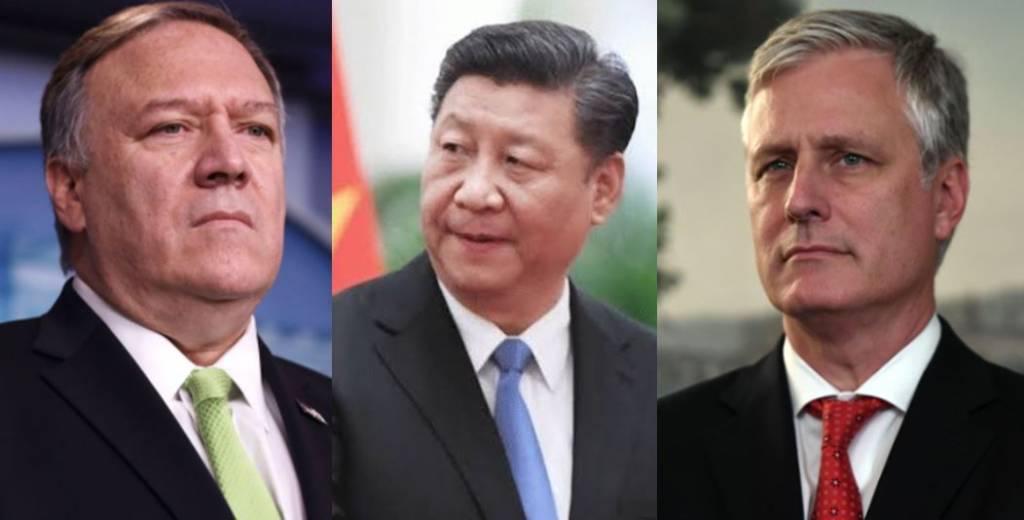The US, of late, has been taking a harsher stance regarding Chinese actions against India on the LAC (Line of Actual Control). The statements by Secretary of State Mike Pompeo & US National Security Advisor Robert O’Brien are signalling US intent for a possible military confrontation with China through India.
The transition of the tone of US from President Trump being hopeful about the capacity of the two countries of solving the issue diplomatically to a now alarmist tone of Mike Pompeo who is warning about the Chinese amassing massive forces at Indian borders shows the intention to persuade India to ally itself with the US for any possible confrontation against China.
He also said that “The world has awakened. The tide’s begun to turn. And the United States under President Trump’s leadership has now built out a coalition that will push back against the threat.”
US National Security Advisor Robert O’Brien tore through the Chinese façade saying it has attempted to seize control of the LAC from India by force. More importantly, he also said the time has come to accept that talks won’t persuade China to go back to status quo ante, indicating that the US favours further degradation in Sino-India ties. Earlier too, by stating that it recognizes Arunachal Pradesh as Indian territory for six decades, the US made it clear that it stands with India in the ensuing border conflict.
All this is happening when Mike Pompeo is scheduled to arrive in New Delhi with Defense Secretary Mark Esper for annual 2+2 talks with their Indian counterparts. The US by these statements is both advising and persuading India to stop efforts of border dispute resolution through dialogues with China, which can lead to blocking all diplomatic channels of dispute resolution with China.
The US, under Donald Trump, is not shying away from blaming China, where it is due. And with every passing day, the language is becoming more and more confrontational. Be it QUAD summit, UNGA (United Nations General Assembly), or any bilateral or multilateral forum, the US in general and Secretary of State Mike Pompeo in particular, are utilizing every platform to lambast China.
This increasingly confrontational tone is going hand in hand with continuous military intimidation and creating deeper alliances in the Chinese neighbourhood. The naval exercises, pan-pacific military exercises, frequent movement of the fleet of ships, submarines, and aircraft carriers can be seen as possible military intimidation.
Read more: Is US planning to conquer China-controlled islands in the South China Sea? Looks very likely
The US is also rebuilding its East Asian alliance system with the help of Japan and a greater Indo-Pacific alliance under the banner of the QUAD (the US, Australia, India and Japan). It is also making new friends in the region be it Mongolia or Vietnam as well as reinvigorating new energy in the ties with the ASEAN member countries.
And in the Indian Ocean as well as China’s western borders, the US wants India to be on the same page and play a vital role. It wants to support India to keep up military pressure on its borders with China as well as blockade Chinese energy requirements passing through the Indian Ocean.
Washington intends to confront China with the help of New Delhi for objective-based confrontation. It would require the help of Indian Armed Forces to keep Chinese busy on the western theatre when simultaneously, the US with its other allies will most likely engage China’s eastern and southern theatres.
The US, presumably, wants to increase the theatres before any formal confrontation. And for that, it wants India to shed diplomatic talks with China so that, as and when the time arrives, the Indian border with US help can become a major theatre which will require China to invest substantial military assets and manpower. The Indian Ocean being strategically favourable to India will also act as a chokehold for Chinese energy supplies.
All of this would consume much of Chinese assets as well as paralyse the military in the long run by stopping any fossil fuel supply through the Indian Ocean. With this, China would become much more susceptible to any possible Eastern Naval confrontation; making it much easier to keep the conflict regional and contained in China and the Indo-Pacific.
Therefore, for the possible military engagement that the US is intending against China, India could play a decisive role. Washington is persuading New Delhi to direct itself against Beijing and consider military options in alliance with the US.
The increasing Chinese belligerence and its wolf warrior diplomacy are disturbing the whole neighbourhood. As Xi Jinping’s China is becoming more of a global bully unbecoming of great power, the US is finding it to be the best possible opportunity to confront China.
Increasing engagement with the Indo-Pacific countries, persuading India to stop diplomatic back and forth which are not leading anywhere, the US is isolating China and creating the best possible opportunity for a probable military confrontation in the near future.
